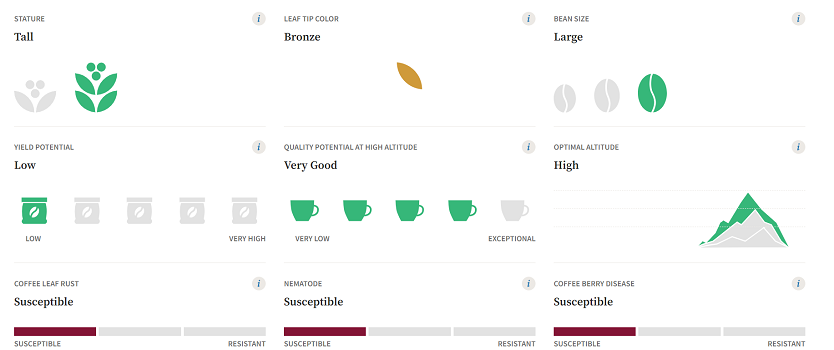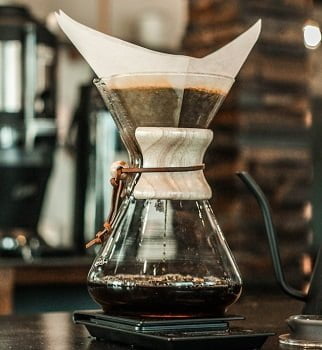Hailed as the “best varietal of Arabica Coffee,” Typica beans originate from Yemen and were first cultivated in India and the volcanic slopes of Java in the 17th century.
Typica beans are vulnerable to disease and have lower yields, but produce a well-balanced cup with spicy notes, making them the gold standard for specialty coffee.

What is Typica coffee?
Typica is one of the most well-known and highly-regarded varieties of coffee. It is part of the Arabica species and is known for its high-quality beans that produce an exquisite cup of coffee.
Typica has a complex yet balanced flavor profile, often described as sweet, smooth, and clean.
The beans have a shape that is elongated and curved compared to other coffee varieties.
This variety goes by many names around the world. It is most famously known as Blue Mountain in Jamaica, Sumatra in Indonesia, and Arabigo in Central America.

Sub Varieties of Typica Coffee
Here are some of the main subvarieties of the Typica coffee beans:
- Blue Mountain – Grown in the Blue Mountain region of Jamaica, known for its mild, sweet flavor with floral notes.
- Sumatra Typica – Grown in Sumatra, Indonesia, and known for full body, low acidity, and earthy, herbal notes.
- Maragogipe – Originated in Brazil – it has a large bean size and rich, intense chocolate flavor.
- San Ramon – Grown in Costa Rica, produces a clean and vibrant cup with hints of caramel.
- Java – The traditional Typica variety grown in Java Island of Indonesia
- Sidamo – Grown in Ethiopia, known for complex citrus and floral notes and medium acidity.
- Kona – The famous Typica variety from Hawaii, known for floral and chocolaty notes
- Arabigo – Grown in Central America, has a rich body with herbal aromas.
- Kent – Grown in India, known for intense aromatics and full body.
- Amarello de Botucatu – Sweet and nutty Brazilian variety.
- Sao Bernardo – From Guatemala, offers a Smooth and balanced taste with chocolate notes.
- Villalobos – From Costa Rica, offers a bright and fruity flavor profile.
Typica Hybrids
The Typica variety has been used to develop several prized hybrids:
- Acaia – Hybrid of Sumatran Typica and Bourbon, known for complex fruit and floral notes.
- Macaturra – A Cross between Maragogipe and Caturra, combines sweetness and body.
- Pacamara – Bred from Pacas and Maragogipe, offers full-bodied and fruity flavors.
- Mundo Novo – Typica and Bourbon hybrid with a balanced, smooth taste – The most cultivated hybrid Arabica species in Brazil
- Catuai – Hybrid of Mundo Novo and Caturra, high-yielding plants with rich flavor.
- Rasuna – Hybrid of Typica and Catimor Variety grown in Sumatra
- Icatu – Hybrid of Mundo Novo and Robusta developed for higher yield and good disease resistance
The best hybrids showcase a fusion of taste profiles and agronomic advantages. Typica genes often lend sweetness, acidity, and aromatic qualities.
What is the history of Typica Coffee?
Typica is believed to have originated in southwestern Ethiopia like all other Arabica Coffees hundreds of years ago. By the 15th or 16th century, Typica was brought across the Red Sea to Yemen, which was the center of the early coffee trade. Its cultivation then expanded along colonial trade routes in the 1700s.
Around 1700, Typica reached India from Yemen. It was also sent to the island of Java, part of present-day Indonesia.
In the 18th century, Typica made its way to the Americas and Africa as European powers established colonial plantations. Countries like Brazil, Guatemala, Costa Rica, Colombia, and Kenya began cultivating the variety.
Over the next couple of centuries, new mutations of Typica emerged. In Brazil, the Mundo Novo and Maragogipe varietals were discovered and bred. Elsewhere, locals selected their own Typica mutations suited to local growing conditions.
While it has been largely replaced by higher-yielding coffee plants in many regions, Typica is still prized by specialty growers. It remains an important variety commercially in places like Jamaica, Peru, and the Dominican Republic.

What are The Characteristics of Typica Coffee?
Typica grows into fairly tall trees with long and conical branches. The plants are not very compact, so they take up more space than other coffee trees. Typica trees are often favored to grow at higher altitudes above 1500 meters in mountainous terrain.

The leaves typically have a dark bronze tip, making them recognizable. The beans themselves are more elongated and curved.
While prized for flavor, Typica gives very low yields – around 30% less than more modern cultivars like Bourbon.
The variety is also more susceptible to pests and diseases which makes it challenging to grow profitably.
However, Typica remains the premier coffee variety in renowned regions like Blue Mountain, Kona, and Sumatra. With proper processing and roasting, its complex flavors shine and fetch higher prices as a specialty coffee.

What does Typica Coffee taste like?
Typica coffee is highly regarded for its sweet, clean, and complex flavor profile. It often has tasting notes of honey, nuts, chocolate, and bright fruit tones when brewed.
The acidity is typically vibrant yet balanced. Its layered flavors make for an exquisite coffee-drinking experience.
I’ve been able to enjoy Typica beans from different origins, each with its own unique qualities.
Jamaica Blue Mountain Typica has struck me with its delicate, floral aroma and mild, almost tea-like flavor with notes of chocolate and nuts.
Sumatran Typica is known for its full-bodied and intense taste with earthy and spicy undertones.
Kona Typica from Hawaii is a bit lighter and brighter, with hints of milk chocolate and ripe citrus.
Typica coffee grown in Hawaii’s Kona region got an 86+ score at the 2022 Kona Coffee Cupping Competition. (An 80+ Score is considered a Speciality coffee)
No matter the origin, Typica always delivers something special in the cup.
How to find and brew the best Typica Coffee?
In my experience, some of the best Typica coffees come from renowned growing regions like the Blue Mountains of Jamaica, Kona in Hawaii, Sumatra in Indonesia, and Mundo Novo Species from Brazil.
When buying Typica beans, I always look for a light or medium roast. The delicate, complex flavors of Typica really shine through when the roast is lighter.
A dark roast would overpower those lovely nuanced notes.
For brewing Typica coffee, slow-drip methods like pour-over and French press work best.
The slow extraction highlights its clean, complex flavors, giving a rich taste without overwhelming acidity.
Personally, I savor this coffee black to appreciate its nuanced profile and subtle sweetness.

Discover Guides on other Coffee beans
Final thoughts
So, there you have it—all about the fascinating Typica coffee variety! From their origin in Ethiopia to the unique flavors they offer, we’ve covered it all. Isn’t it amazing how these beans have such a rich history and diverse tastes?
Have you had the pleasure of trying a well-crafted Typica before? I’d love to hear about your experiences in the comments below! What origins or roasts stood out to you? How did you brew it? Tell us your favorite Typica coffee moment
Check out a guide on Different Types of Coffee Beans
FAQs
What is the difference between typica and bourbon coffee?
Typica and Bourbon are two distinct coffee varieties that fall under the same parent species “Coffea Arabica“
Typica beans tend to be elongated and grow on tall coffee plants, while Bourbon beans are rounder and typically grow on shorter shrub-like plants.
Typica has a balanced, mild taste with hints of nuts and spice while
Bourbon has a brighter, more acidic taste with fruity notes.
What are the 4 major coffee beans?
The 4 major types of Coffee beans are
1- Arabica
2- Robusta
3- Excelsa
4- Liberica
Over 97% of coffee production is Arabica and Robusta. Typica itself is a sub-variety of Arabica.




Very cool to read about the oldest arabica varietal. I’ve seen it used in several coffee blends but never as a single origin. Will have to hunt for those beans.
Yeah, it’s pretty rare as a single origin. Definitely worth trying if you can find it.
This made me want to try Typica beans from different countries. I’ve only had Kona so far. What’s the most flavorful Typica you’ve tried? Should I go for Jamaican Blue Mountain next?
I’ve tried Typica from Sumatra and it was amazing — earthy and rich. Definitely underrated!